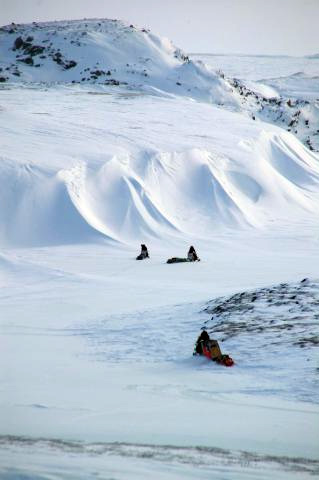
Alaska Science Snow researcher finds his ArcticBy NED ROZELL
November 05, 2012
After 45 brilliant and bleak days, you complete a difficult journey that brings you closer to the long-dead adventurers you have read about and admired. And, because of your stellar reputation and the smarts you have gathered in three decades of work in the far north, you got paid to do it. Matthew Sturm accomplished a lot in a 2,500-mile snowmachine journey from Fairbanks to Hudson Bay in 2007, when he was 54. The University of Alaska Press this year published the snow scientist’s book about the journey, “Finding the Arctic.” In the book, Sturm reveals himself as kindred soul to those who long ago tramped across the north looking for adventure in one of the few regions on Earth less populated now than it was a century ago. Though gathering snow samples was part of his journey as it has been on his many less-publicized-though-still-impressive trips throughout Alaska’s Arctic, not much science finds its way to the pages of “Finding the Arctic.” That’s a good thing. Sturm has instead written a reflective travelogue, pausing at lonely windblown places in the wilds of Alaska and northern Canada. There, he ponders the lives of those who had stood in the same place not long ago, but light years away from satellite phones and handheld devices that tell you precisely where you are standing. Before the trip, while mapping his journey from Fairbanks to Nunavut, Sturm drew a line over paths slogged by northern explorers, such as the Scotsman Alexander Mackenzie, who in the late 1700s was looking for a link to the Pacific but ended up leaving his name on a giant northern river. Sturm also wanted to switch off his Skandik snowmachine on the middle of the Eagle River in the Yukon Territory. There, he planned to absorb the silence of the spot where the Mad Trapper of Rat River fell to the bullets of Royal Canadian Mounted Police. With some admiration for a man who for 52 frigid days in winter 1932 outfoxed his pursuers (who came after him because of a trapping dispute and were greeted by a rifle shots fired through his cabin door), Sturm re-tells the story of Albert Johnson. He also describes the practical decision that led to his caravan bypassing the precise spot of Johnson’s death; they heeded the advice of locals in the village of Old Crow who warned of a wet, dangerous river approach to the Eagle River. After a few more failures at sniffing out the remnants of stories that had fired his armchair imagination, Sturm, along with his companions, found the history they sought on the frozen Dease River, which flows into the Northwest Territories’ Great Bear Lake (one of the ten largest fresh-water basins on Earth). There, Jon Holmgren, mechanical wizard and a friend of Sturm’s since their college/climbing days, saw the roofless log remains of a cabin belonging to brothers George and Lionel Douglas. The five travelers - Holmgren, Dan Solie, Henry Huntington and Glen Liston shared the trail with Sturm (they were joined later by Canadians Chris Derksen and Arvids Silis) - parked their heavy machines and camped near Douglas’s cabin. “As the sun set . . . it cast a golden light on the snow and made the spruce trees a rich dark green,” Sturm wrote. “This light, this view, all would have been familiar to Douglas, or to (British explorer John) Franklin, or to a Native hunter traveling this route five hundred years ago. “If George and Lionel Douglas had come swinging down the river after a long day of hunting, it would not have surprised us much. And other than the strange black machines sitting in their yard, our being (there) would not have been much of a surprise to them either. Lots of travelers came by the point in the winter of 1911-1912. We would have offered them some hot tea to chase off the evening cold and swapped travelers’ yarns long into the night.” This reader got the feeling that Sturm is one of those people who would have been quite happy tromping through the Arctic a few hundred years ago, without IPod buds sewn into his earflaps or arranged fuel caches. Sturm described the time before aircraft as “a primitive and pristine world that was grand and violent.” Sturm comes across as someone who forged a career at the U.S. Army Cold Regions Research and Engineering Laboratory on Fort Wainwright because he loves digging snow pits and has an underlying passion for the north. He seemed to be describing himself when he wrote about George Douglas, with whom Sturm would have been delighted to share the heat of the sandstone fireplace on Dease Inlet in the days of dogsleds and riverboats. “On the surface, (Douglas’s) venture appears to have been a sober, straightforward search for copper,” Sturm wrote. “But a closer look at Douglas’s writing, and his riveting black and white photographs, suggests a very different motive. He came for adventure and romance. The North was clean and invigorating: it had unlimited possibilities.”
Since the late 1970s, the University of Alaska Fairbanks’ Geophysical Institute has provided this column free in cooperation with the UAF research community.
E-mail your news &
photos to editor@sitnews.us
|
|||
